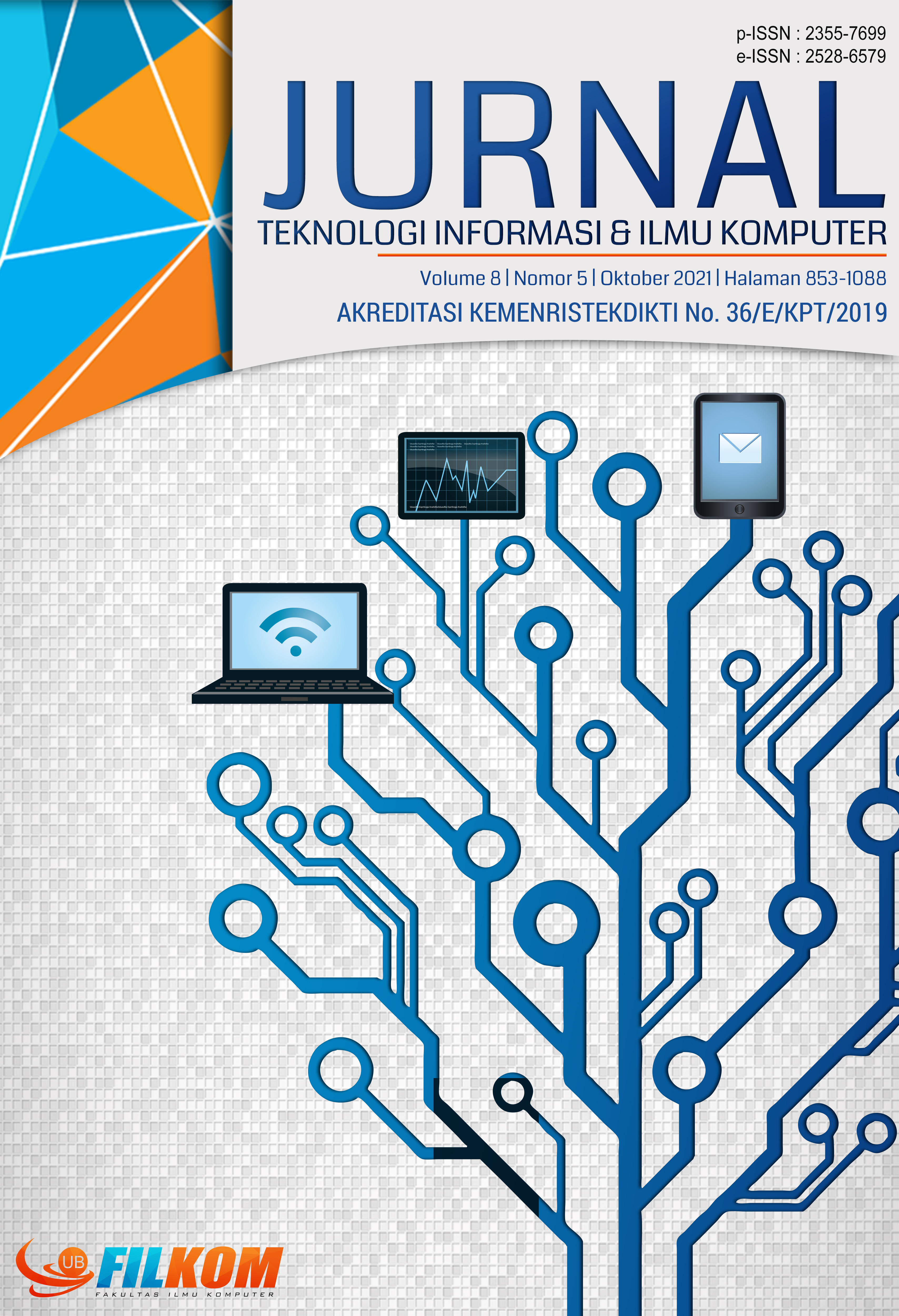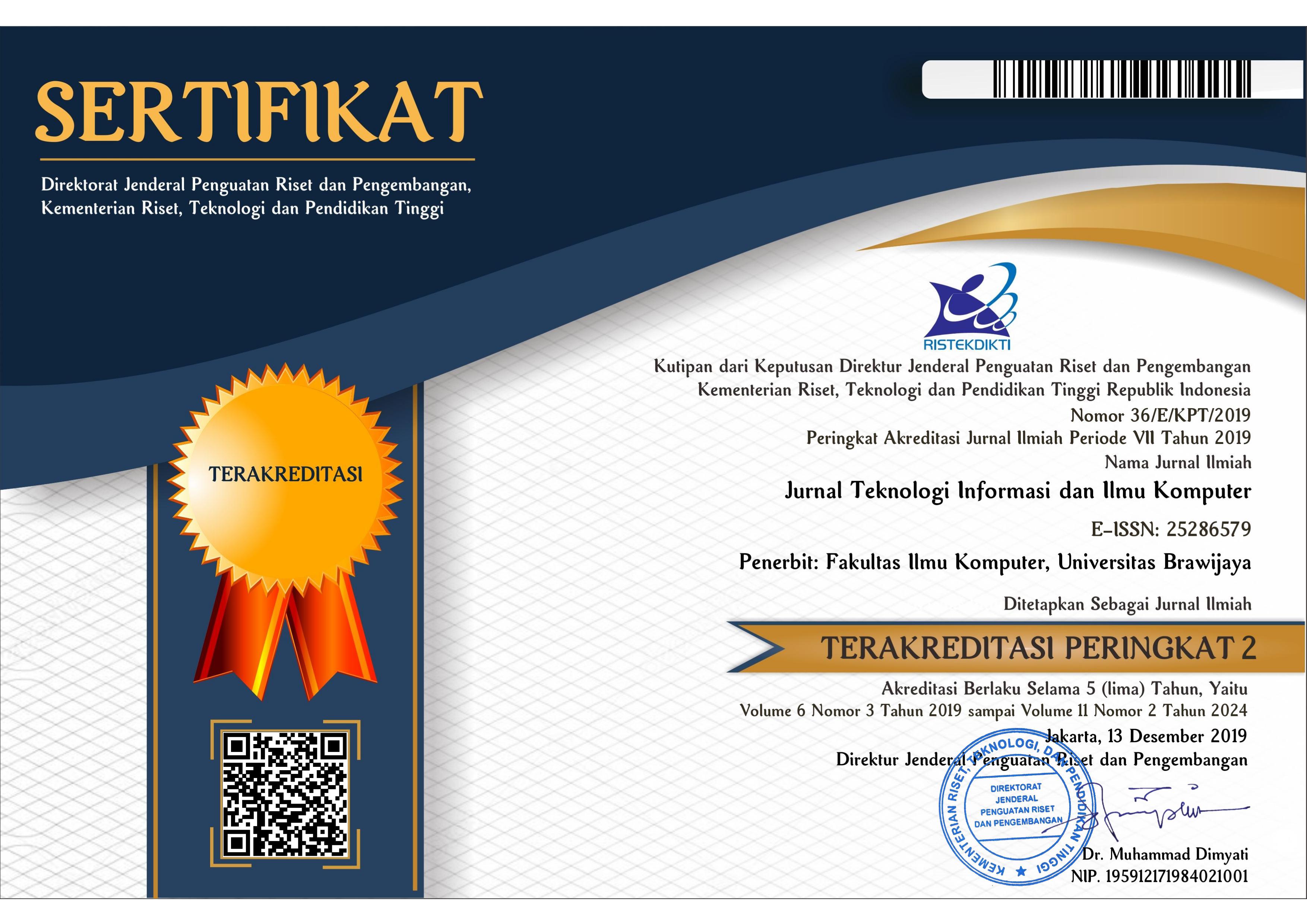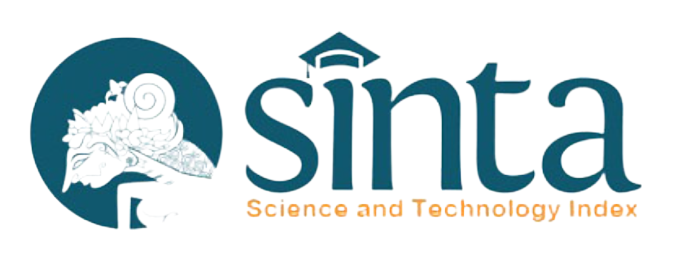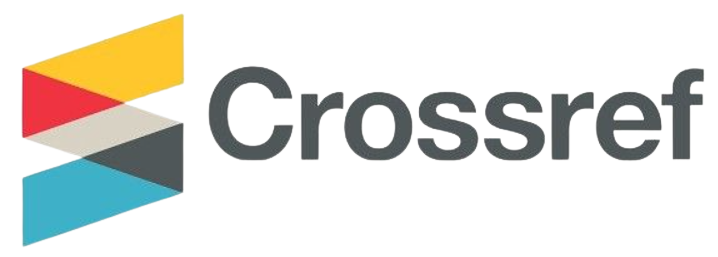Klasifikasi Teks Hadis Bukhari Terjemahan Indonesia Menggunakan Recurrent Convolutional Neural Network (CRNN)
DOI:
https://doi.org/10.25126/jtiik.2021853750Abstrak
Hadis merupakan sumber hukum dan pedoman kedua bagi umat Islam setelah Al-Qur’an dan banyak sekali hadis yang telah diriwayatkan oleh para ahli hadis selama ini. Penelitian ini membangun sebuah sistem yang dapat melakukan klasifikasi teks hadis Bukhari terjemahan berbahasa Indonesia. Topik ini diangkat untuk memenuhi kebutuhan umat Islam dalam mengetahui apa saja informasi mengenai anjuran dan larangan yang terdapat dalam suatu hadis. Klasifikasi teks memiliki tantangannya tersendiri terkait dengan jumlah fitur yang sangat banyak (dimensi sangat besar) sehingga waktu komputasi menjadi besar dan mengakibatkan sulitnya mendapatkan hasil yang optimal. Pada penelitian ini, digunakan salah satu metode hibrid dalam dunia deep learning dengan menggabungkan Convolutional Neural Network dan Recurrent Neural Network, yaitu Convolutional Recurrent Neural Network (CRNN). Convolutional Neural Network dipilih sebagai metode seleksi dan reduksi data dikarenakan dapat menangkap informasi spasial yang saling berhubungan dan berkorelasi. Sementara Recurrent Neural Network digunakan sebagai metode klasifikasi dengan mengusung kemampuan utamanya yaitu dapat menangkap informasi kontekstual yang sangat panjang khususnya pada data sekuens seperti data teks dengan mengandalkan ‘memori’ yang dimilikinya. Hasil penelitian menyajikan beberapa hasil klasifikasi menggunakan deep learning, dimana hasil akurasi terbaik diberikan oleh Convolutional Recurrent Neural Network (CRNN), yakni sebesar 80.79%.
Abstract
Hadith is a source of law and guidance for Muslims after the Qur'an and many hadith have been narrated by hadith experts so far. This research builds a system that can classify Bukhari hadith in Indonesian translations. This topic was raised to meet the needs of Muslims in knowing what information about the suggestions and prohibitions that exist in a hadith. Text classification has its own challenges related to several features whose dimensions are very large so that it increases computing time and causes difficulties in getting optimal results. This research uses a hybrid method in deep learning by combining a Convolutional Neural Network and a Recurrent Neural Network, namely Convolutional Recurrent Neural Network (CRNN). Convolutional Neural Network was chosen as a method of selecting and reducing data that can be determined as spatial information that is interrelated and correlated. While Recurrent Neural Networks are used as a classification method by carrying out capabilities that can be used as very long contextual information specifically on sequential data such as text data by relying on the ‘memory’ it has. This research presents several classification results using deep learning, where the best accuracy results are given by the Convolutional Recurrent Neural Network (CRNN), which is equal to 80.79%.
Downloads
Referensi
ABDI, A., SHAMSUDDIN, S. M., HASAN, S., & PIRAN, J. 2019. Deep learning-based sentiment classification of evaluative text based on Multi-feature fusion. Information Processing and Management, 56(4), 1245–1259. https://doi.org/10.1016/j.ipm.2019.02.018
ABU BAKAR, M. Y., ADIWIJAYA, & AL FARABY, S. 2019. Multi-Label Topic Classification of Hadith of Bukhari (Indonesian Language Translation)Using Information Gain and Backpropagation Neural Network. Proceedings of the 2018 International Conference on Asian Language Processing, IALP 2018, 344–350. https://doi.org/10.1109/IALP.2018.8629263
AGARAP, A. F. 2018. Deep Learning using Rectified Linear Units (ReLU). 1, 2–8. http://arxiv.org/abs/1803.08375
AL-ANZI, F. S., & ABUZEINA, D. 2017. Toward an enhanced Arabic text classification using cosine similarity and Latent Semantic Indexing. Journal of King Saud University - Computer and Information Sciences, 29(2), 189–195. https://doi.org/10.1016/j.jksuci.2016.04.001
AL-KABI, M. N., GHASSAN, K., AL-SHALABI, R., AL-SINJILAWI, S. I., & AL-MUSTAFA, R. S. 2005. Al-Hadith Text Classifier. Journal of Applied Sciences, 5(3), 584–587. https://doi.org/10.3923/jas.2005.584.587
AL FARABY, S., JASIN, E. R. R., KUSUMANINGRUM, A., & ADIWIJAYA. 2018. Classification of hadith into positive suggestion, negative suggestion, and information. Journal of Physics: Conference Series, 971(1). https://doi.org/10.1088/1742-6596/971/1/012046
ALDHLAN, K. A., ZEKI, A. M., ZEKI, A. M., & ALRESHIDI, H. A. 2013. Novel mechanism to improve hadith classifier performance.
Proceedings - 2012 International Conference on Advanced Computer Science Applications and Technologies, ACSAT 2012, 512–517. https://doi.org/10.1109/ACSAT.2012.93
BURGOS-ARTIZZU, X. P., PERONA, P., & DOLLAR, P. 2013. Robust Face Landmark Estimation under Occlusion. 2013 IEEE International Conference on Computer Vision, 1513–1520. https://doi.org/10.1109/ICCV.2013.191
CHEN, B., HUANG, Q., CHEN, Y., CHENG, L., & CHEN, R. 2019. Deep Neural Networks for Multi-class Sentiment Classification. Proceedings - 20th International Conference on High Performance Computing and Communications, 16th International Conference on Smart City and 4th International Conference on Data Science and Systems, HPCC/SmartCity/DSS 2018, 854–859.
https://doi.org/10.1109/HPCC/SmartCity/DSS.2018.00142
CHEN, G., YE, D., XING, Z., CHEN, J., & CAMBRIA, E. 2017. Ensemble application of convolutional and recurrent neural networks for multi-label text categorization. Proceedings of the International Joint Conference on Neural Networks, 2017-May, 2377–2383. https://doi.org/10.1109/IJCNN.2017.7966144
CHOI, K., FAZEKAS, G., SANDLER, M., & CHO, K. 2017. Convolutional recurrent neural networks for music classification. 2017 IEEE International Conference on Acoustics, Speech and Signal Processing (ICASSP), 2392–2396. https://doi.org/10.1109/ICASSP.2017.7952585
DAELI, N. O. F., & ADIWIJAYA. 2020. Sentiment analysis on movie reviews using Information gain and K-nearest neighbor. JOURNAL OF DATA SCIENCE AND ITS APPLICATIONS, 3(1), 1–7. Https://Doi.Org/10.34818/JDSA.2020.3.22
DENG, J., SUN, Y., LIU, Q., & LU, H. 2015. Low rank driven robust facial landmark regression. Neurocomputing, 151(P1), 196–206. HTTPS://DOI.ORG/10.1016/J.NEUCOM.2014.09.052
FAUZAN, H., ADIWIJAYA, A., & AL-FARABY, S. 2018. Pengklasifikasian Topik Hadits Terjemahan Bahasa Indonesia Menggunakan Latent Semantic Indexing dan Support Vector Machine. Jurnal Media Informatika Budidarma, 2(4), 131. https://doi.org/10.30865/mib.v2i4.948
HARRAG, F., & EL-QAWASMAH, E. 2009. Neural network for Arabic text classification. 2nd International Conference on the Applications of Digital Information and Web Technologies, ICADIWT 2009, 778–783. https://doi.org/10.1109/ICADIWT.2009.5273841
HERLAMBANG, A. D., & WIJOYO, S. H. 2019. Algoritma Naive Bayes untuk Klasifikasi Sumber Belajar Berbasis Teks pada Mata Pelajaran Produktif di SMK Rumpun Teknologi Informasi dan Komunikasi. Jurnal Teknologi Informasi Dan Ilmu Komputer, 6(4), 430. https://doi.org/10.25126/jtiik.2019641323
HIDAYATI, D. C., AL FARABY, S., & ADIWIJAYA, A. 2020. Klasifikasi Topik Multi Label pada Hadis Shahih Bukhari Menggunakan K-Nearest Neighbor dan Latent Semantic Analysis. JURIKOM (Jurnal Riset Komputer), 7(1), 140.
https://doi.org/10.30865/jurikom.v7i1.2013
HMEIDI, I., AL-AYYOUB, M., ABDULLA, N. A., Almodawar, A. A., Abooraig, R., & Mahyoub, N. A. 2015. Automatic Arabic text categorization: A comprehensive comparative study. Journal of Information Science, 41(1), 114–124. https://doi.org/10.1177/0165551514558172
HU, W., HUANG, Y., WEI, L., ZHANG, F., & LI, H. 2015. Deep Convolutional Neural Networks for Hyperspectral Image Classification. Journal of Sensors, 2015, 1–12. https://doi.org/10.1155/2015/258619
IDE, H., & KURITA, T. 2017. Improvement of learning for CNN with ReLU activation by sparse regularization. Proceedings of the International Joint Conference on Neural Networks, 2017-May, 2684–2691. https://doi.org/10.1109/IJCNN.2017.7966185
JOHNSON, R., & ZHANG, T. 2015. Semi-supervised convolutional neural networks for text categorization via region embedding. Advances in Neural Information Processing Systems, 2015-Janua, 919–927.
KARLIK, B., & OLGAC, V. A. 2011. Performance Analysis of Various Activation Functions in Artificial Neural Networks. International Journal of Artificial Intelligence And Expert Systems (IJAE), 1(4), 111–122. https://doi.org/10.1088/1742-6596/1237/2/022030
KETKAR, N. 2017. Deep Learning with Python. In Deep Learning with Python. Apress. https://doi.org/10.1007/978-1-4842-2766-4
KRIZHEVSKY, A., SUTSKEVER, I., & HINTON, G. E. 2017. ImageNet classification with deep convolutional neural networks. Communications of the ACM, 60(6), 84–90. https://doi.org/10.1145/3065386
LAI, S., XU, L., LIU, K., & ZHAO, J. 2015. Recurrent convolutional neural networks for text classification. Proceedings of the National Conference on Artificial Intelligence, 3, 2267–2273.
LECUN, Y., BENGIO, Y., & HINTON, G. 2015. Deep learning. Nature, 521(7553), 436–444. https://doi.org/10.1038/nature14539
LI, R., LIU, W., LIN, Y., ZHAO, H., & ZHANG, C. 2017. An Ensemble Multilabel Classification for Disease Risk Prediction. Journal of Healthcare Engineering, 2017. https://doi.org/10.1155/2017/8051673
LI, S., LI, W., COOK, C., ZHU, C., & GAO, Y. 2019. A fully trainable network with RNN-based pooling. Neurocomputing, 338(Shuai Li), 72–82. https://doi.org/10.1016/j.neucom.2019.02.004
LIANG, H., SUN, X., SUN, Y., & GAO, Y. 2017. Text feature extraction based on deep learning: a review. Eurasip Journal on Wireless Communications and Networking, 2017(1), 1–12. https://doi.org/10.1186/s13638-017-0993-1
LUO, Y. 2017. Recurrent neural networks for classifying relations in clinical notes. Journal of Biomedical Informatics, 72, 85–95. https://doi.org/10.1016/j.jbi.2017.07.006
MEDIAMER, G., ADIWIJAYA & FARABY, S. A. 2019. l.. Development of rule-based feature extraction in multi-label text classification. International Journal on Advanced Science, Engineering and Information Technology, 9(4), 1460–1465. https://doi.org/10.18517/ijaseit.9.4.8894
MUSLIM POPULATION BY COUNTRY 2020. (n.d.). Retrieved October 18, 2020, from https://worldpopulationreview.com/country-rankings/muslim-population-by-country
NWANKPA, C., IJOMAH, W., GACHAGAN, A., & MARSHALL, S. 2018. Activation Functions: Comparison of trends in Practice and Research for Deep Learning. 1–20. http://arxiv.org/abs/1811.03378
PINHEIRO, R. H. W., CAVALCANTI, G. D. C., & REN, T. I. 2015. Data-driven global-ranking local feature selection methods for text categorization. Expert Systems with Applications, 42(4), 1941–1949. https://doi.org/10.1016/j.eswa.2014.10.011
PRUSA, J. D., & KHOSHGOFTAAR, T. M. 2017. Improving deep neural network design with new text data representations. Journal of Big Data, 4(1). https://doi.org/10.1186/s40537-017-0065-8
PURBOLAKSONO, M. D., RESKYADITA, F. D., ADIWIJAYA, SURYANI, A. A., & HUDA, A. F. 2020. Indonesian text classification using back propagation and sastrawi stemming analysis with information gain for selection feature. International Journal on Advanced Science, Engineering and Information Technology, 10(1), 234–238. https://doi.org/10.18517/ijaseit.10.1.8858
PURNOMOPUTRA, R. B., & WISESTY, U. N. 2019. Sentiment Analysis of Movie Reviews using Naïve Bayes Method with Gini Index Feature Selection. Journal of Data Science and Its Applications, 2(July), 85–94. https://doi.org/10.34818/jdsa.2019.2.36
SHIMPIKAR, S., & GOVILKAR, S. 2017. A Survey of Text Summarization Techniques for Indian Regional Languages. International Journal of Computer Applications, 165(11), 29–33. https://doi.org/10.5120/ijca2017914083
SIGTIA, S., BENETOS, E., & DIXON, S. 2016. An end-to-end neural network for polyphonic piano music transcription. IEEE/ACM Transactions on Audio Speech and Language Processing, 24(5), 927–939. https://doi.org/10.1109/TASLP.2016.2533858
SIVARAM, M., PORKODI, V., MOHAMMED, A. S., & MANIKANDAN, V. 2019. Detection of accurate facial detection using hybrid deep convolutional recurrent neural network. 1844–1850. https://doi.org/10.21917/ijsc.2019.0256
TALATHI, S. S., & VARTAK, A. 2015. Improving performance of recurrent neural network with relu nonlinearity. http://arxiv.org/abs/1511.03771
WANG, B. 2018. Disconnected recurrent neural networks for text categorization. ACL 2018 - 56th Annual Meeting of the Association for Computational Linguistics, Proceedings of the Conference (Long Papers), 1, 2311–2320. https://doi.org/10.18653/v1/p18-1215
YAMASHITA, R., NISHIO, M., DO, R. K. G., & TOGASHI, K. 2018.
Convolutional neural networks: an overview and application in radiology. Insights into Imaging, 9(4), 611–629. https://doi.org/10.1007/s13244-018-0639-9
ZHANG, J., SHAN, S., KAN, M., & CHEN, X. 2014. Coarse-to-Fine Auto-Encoder Networks (CFAN) for Real-Time Face Alignment (pp. 1–16). https://doi.org/10.1007/978-3-319-10605-2_1
ZHANG, X., ZHAO, J., & LECUN, Y. 2015. Character-level Convolutional Networks for Text Classification. Advances in Neural Information Processing Systems, 649–657. http://arxiv.org/abs/1502.01710
ZHANG, Z., LUO, P., LOY, C. C., & TANG, X. 2014. Facial Landmark Detection by Deep Multi-task Learning. Proceedings of International Conference on European Conference on Computer Vision, 94–108. https://doi.org/10.1007/978-3-319-10599-4_7
ZUO, Z., SHUAI, B., WANG, G., LIU, X., WANG, X., WANG, B., & CHEN, Y. 2015. Convolutional recurrent neural networks: Learning spatial dependencies for image representation. IEEE Computer Society Conference on Computer Vision and Pattern Recognition Workshops, 2015-Octob, 18–26. https://doi.org/10.1109/CVPRW.2015.7301268
Unduhan
Diterbitkan
Terbitan
Bagian
Lisensi

Artikel ini berlisensi Creative Common Attribution-ShareAlike 4.0 International (CC BY-SA 4.0)
Penulis yang menerbitkan di jurnal ini menyetujui ketentuan berikut:
- Penulis menyimpan hak cipta dan memberikan jurnal hak penerbitan pertama naskah secara simultan dengan lisensi di bawah Creative Common Attribution-ShareAlike 4.0 International (CC BY-SA 4.0) yang mengizinkan orang lain untuk berbagi pekerjaan dengan sebuah pernyataan kepenulisan pekerjaan dan penerbitan awal di jurnal ini.
- Penulis bisa memasukkan ke dalam penyusunan kontraktual tambahan terpisah untuk distribusi non ekslusif versi kaya terbitan jurnal (contoh: mempostingnya ke repositori institusional atau menerbitkannya dalam sebuah buku), dengan pengakuan penerbitan awalnya di jurnal ini.
- Penulis diizinkan dan didorong untuk mem-posting karya mereka online (contoh: di repositori institusional atau di website mereka) sebelum dan selama proses penyerahan, karena dapat mengarahkan ke pertukaran produktif, seperti halnya sitiran yang lebih awal dan lebih hebat dari karya yang diterbitkan. (Lihat Efek Akses Terbuka).












